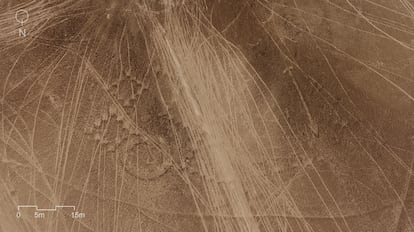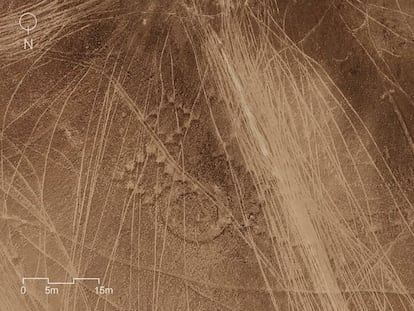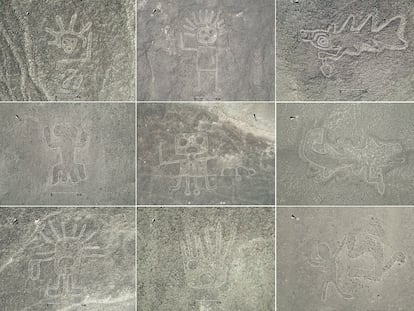Vehicles destroying ancient geoglyphs in the Atacama Desert: ‘The damage is irreversible’
Chile has failed to stop cars driving over the large designs etched into the rock of this vast landscape. Aerial images this September revealed the extent of the destruction


When the Atacama Desert Foundation posted the damage that a variety of motorized vehicles have caused to the Alto Barranco geoglyphs in the Tarapacá region of northern Chile on social networks in early September, there were global repercussions. “The images are really shocking because of the extent of the contact,” says Gonzalo Pimentel, director of the Chilean NGO.
The visual evidence, taken with aerial cameras, shows how the four-meter figures elaborated by pre-Hispanic Andean peoples on the stones of Alto Barraco more than 1000 years ago, are being erased by the relentless passage of jeeps, motorbikes and ATVs. Pimentel explains that this archaeological site has “unfortunately been destroyed for several decades by the passage of off-road vehicles and it seems there’s no end in sight.”
Largely concentrated in the regions of Arica and Tarapacá, in the extreme north of the country, the geoglyphs in Chile were drawn between 3,000 and 1,000 years ago, depicting geometric, zoomorphic and anthropomorphic figures, to help with orientation, as Marcela Sepúlveda, president of the Chilean Society of Archeology, tells EL PAÍS. “The most important thing is the interaction between the communities and their landscape, because it is almost a cartography,” he says. “It is a map containing specific landmarks: routes to follow, water sources, meeting places. This is key to inhabiting the desert and being able to move through a space that seems so inhospitable.”
According to Sepúlveda, ”It is necessary to emphasize the knowledge that exists in the production of geoglyphs. We are talking about the handling of dimensions, of measurements, of being able to depict an image on a monumental scale.”
These archaeological sites have been invaded for years by people riding roughshod over them in motorized vehicles of various descriptions. “Most of the damage is irreversible,” says Pimentel, noting its magnitude. “Although there are restoration techniques that could be applied, it seems to me that because of the extent of the damage, it is almost impossible to return them to the way they once were.”
Pimental adds that the destruction of the geoglyphs is increasing daily, not only by driving over them, but also by the mining in the region.
The damage to heritage sites has to do with a degree of ignorance, says Sepúlveda, who has been reporting damage to both the Public Prosecutor’s Office and the police since 2005: “The case of Alto Barranco is a tragedy and is cumulative. These geoglyphs are not found everywhere — they are unique and there are many of them in the Atacama Desert, which means we have a global responsibility to preserve them.”
Calogero Santoro, an archaeologist and academic at the Universidad de Tarapacá, tells EL PAÍS that “Chile is normally known for its mining and astronomy, but archaeology is also invaluable because it shows the creative capacity of the people who lived in extreme environments like the Atacama Desert. The geoglyphs are an example of this creativity; the monumentality and complexity of these geoglyphs in the north of Chile is not found anywhere else.”

In Chile, geoglyphs are protected by the National Monuments Law and belong to the state. The problem, explains Sepúlveda, is that “although all the sites are protected, not all of them have special categories for particular protection projects. Most of the monuments in Chile are unprotected, unless they have a particular project. For example, the geoglyphs of Pintados near Iquique in the Tarapacá region, are within a National Forestry Corporation [Conaf] reserve and are preserved because Conaf is in charge of them.”
According to Pimentel, “the state and its relevant agencies, such as the National Monuments Council, have not been up to the task of designing, implementing and sustaining a minimum policy for the protection, safeguarding and enhancement” of these highly relevant sites. Meanwhile, Calogero Santoro says that while it is important there are laws to protect these archaeological sites, “the laws must be complied with by the people. This has to do with education, people must be made aware of the importance of protecting and cultivating these remains.”
Chile’s Minister of National Assets, Marcela Sandoval, insists these sites are protected by law. “That already defines a different status, which is accompanied by signage and information campaigns. We are calling for citizens to collaborate in their care, rather than simply being reactive to the punishment and control that the State can deploy in a territory that, it must be said, is very extensive.”
In the case of the Alto Barranco geoglyphs, the Ministry of National Assets says they have increased signage and sent the background information to the State Defense Council to evaluate legal action regarding the damage that “could constitute a crime at the site.”
Sign up for our weekly newsletter to get more English-language news coverage from EL PAÍS USA Edition
Tu suscripción se está usando en otro dispositivo
¿Quieres añadir otro usuario a tu suscripción?
Si continúas leyendo en este dispositivo, no se podrá leer en el otro.
FlechaTu suscripción se está usando en otro dispositivo y solo puedes acceder a EL PAÍS desde un dispositivo a la vez.
Si quieres compartir tu cuenta, cambia tu suscripción a la modalidad Premium, así podrás añadir otro usuario. Cada uno accederá con su propia cuenta de email, lo que os permitirá personalizar vuestra experiencia en EL PAÍS.
¿Tienes una suscripción de empresa? Accede aquí para contratar más cuentas.
En el caso de no saber quién está usando tu cuenta, te recomendamos cambiar tu contraseña aquí.
Si decides continuar compartiendo tu cuenta, este mensaje se mostrará en tu dispositivo y en el de la otra persona que está usando tu cuenta de forma indefinida, afectando a tu experiencia de lectura. Puedes consultar aquí los términos y condiciones de la suscripción digital.
More information
Archived In
Últimas noticias
Daytime, headphones, no booze involved: How a generation is saying ‘no’ to club parties
Millennia-old Yuracaré language resists extinction through 900 speakers and a new dictionary
Susan Boyle prepares a comeback just as Timothée Chalamet sings her praises
Trump suspends green card visa lottery after shooting at Brown University
Most viewed
- Christian Louboutin: ‘Young people don’t want to be like their parents. And if their parents wear sneakers, they’re going to look for something else’
- Cartels in Mexico take a leap forward with narco-drones: ‘It is criminal groups that are leading the innovation race’
- Liset Menéndez de la Prida, neuroscientist: ‘It’s not normal to constantly seek pleasure; it’s important to be bored, to be calm’
- ‘El Limones’ and the growing union disguise of Mexican organized crime
- US sanctions against jailed cartel leader ‘El Marro’ highlight Mexico’s lack of control over its prisons










































